|
FAQs on Flasher Wrasses, Genus Paracheilinus
Identification
Related Articles: Flasher Wrasses,
Related FAQs: Flasher Wrasses, & FAQs on:
Flasher Wrasse Behavior, Flasher Wrasse Compatibility, Flasher Wrasse Selection, Flasher Wrasse Systems, Flasher Wrasse Feeding, Flasher Wrasse Disease, Flasher Wrasse Reproduction, &
Wrasses, Wrasse Selection, Wrasse Behavior, Wrasse Compatibility, Wrasse Feeding, Wrasse Diseases,
|
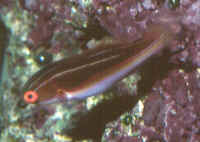
|
|
ID for fishes from Sulawesi 1/30/18
Bob,
would you, please, identify these fishes from Sulawesi
regards,
Igor
<Hey Igor! Will try my best, the first appears to be Valenciennea limicola,
a/the Mud Goby; the second is a juvenile to first phase/female wrasse, likely a
Paracheilinus species, possibly P. filamentosus, though there are other species
found in Sulawesi. The last fish is a Gerrid, likely Gerres acinaces, the
Longtail Silver Biddy; though the fish is a little off... this appears to be a
night dive shot. Cheers, Bob Fenner>
thank you!
|
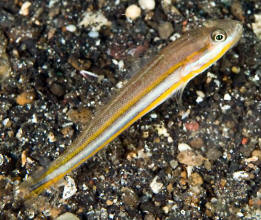
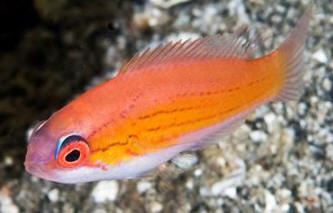 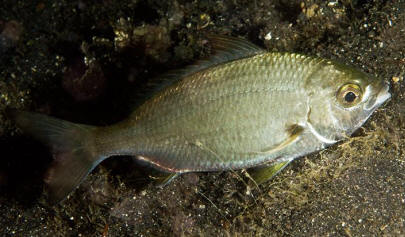 |
|
Sick flasher
2/21/15
I obtained a small flasher wrasse (not sure if this is a carpenter or a
yellow fin, maybe you can help identify)
<The more distinct markings on the caudal; though I can't see much
darkening on the posterior proximal dorsal, I make this out to be a
Carpenter's>
on Feb 13. I housed this in an isolation box with a
lineopunctatus flasher (with dividers) beside it.
<Mmm; these fishes REALLY don't like being penned in...>
In the system also have 4 flavo anthiases which (the male is pictured) I
think has been slowly losing weight (all 4 Anthias.)
<Common AND REAL trouble... Need to bolster nutrition, AND lace the
foods with anti-protozoal AND anthelminthic med.s: Metronidazole and
Prazi are my choices>
The anthiases have been eating Reef nutrition ArctiPods and Cyclopeeze
2x a day but I have noticed that they have large bellies and getting
really thin.
<As stated; okay, hinted above; likely internal issues>
They sometimes swim slanted like "/" but sometimes normally, Im not sure
if it is my high flow.
<Mmm; could be damage in collection... being brought up too quickly>
The system is around 40Galons total with sump/skimmer/chiller and some
corals (it is actually a QT system)
<I'd rapid transit these fishes into a larger setting>
Anyway, just today, I noticed this lesion on my small flasher
wrasse. Any chance you can help identify it?
<Appears to be physical damage to me... VERY common (am getting to not
like these capitalizations) with these genera... JUMPING!>
Should I remove this wrasse to another tank so the sickness does not
spread?
<Again... am NOT a fan of much/any isolation of these fishes in small
volumes... Would rather dip/bath and put straight away into their
main/display system>
I have read about myobacterium marinum, if this is the case, how do I
rid my QT tank of it?
<Let's not go there this eve; too involved and not necessary>
Thank you.
<Welcome Michael. Bob Fenner> |
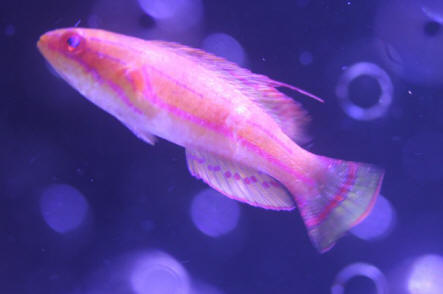
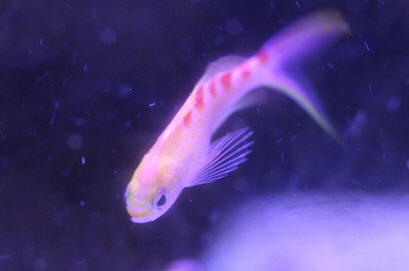 |
|
Re: re: Sick flasher
2/22/15
Thank you for the fast response! This is another picture of another flasher
that I bought. carpenteri or flavianisis?
<The latter... though you've misspelled flavianalis. B> |
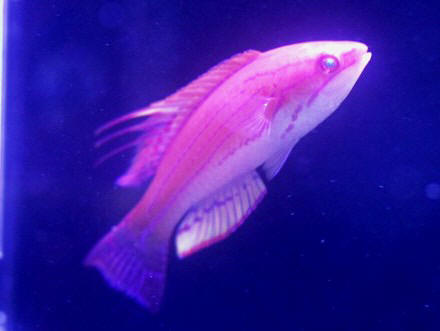 |
Cirrhilabrus-fan Dear Mr. Bob Fenner, <Yosh!> My name
is Hiroyuki Tanaka, a long-time marine aquarist. <Pleased to meet
you> I saw your web for the first time and I was impressed with the
part of photos and comments for Cirrhilabrus and Paracheilinus. That
are one of my most favorites. I actually am writing a book on three
genera including these with Conniella. Then I now have over 600 photos
of every species, including the undescribed sent by many friends all
over the world. I hope that the book would be out in 2004-5. <Sounds
very good. Are you familiar with the ten volume series Rudie Kuiter and
Helmut Debelius are producing through Tropic Marine Centre... a couple
are to cover the popular Labrid genera. You can get an idea of what
these might be/cover here: www.tmc-ltd.co.uk> Well let me correct
and add some things in the web. 1 Cirrhilabrus part. It comprises 40
species at present and one would be added so soon; it is from Coral Sea
and will be described by Randall and Nagareda. C. solorensis is a valid
one now. <Yes, saw this in a paper this last week> C.
filamentosus photo is shown in your C. rubriventralis part, on the
right photo. <Thank you for this correction> Photo of C.
cyanopleura is shown as C. rubripinnis. <And this one!> Who took
photo of C. blatteus shown there? Yours? <Yes> It is very
good. I hope to get such photographs in my book. <You are
welcome to use my photographs my friend. Let me know what sort of
output/scans I can supply you. Most all current ones are 300 dpi tiffs,
at 2.3 megs each> It is one of the rarest seen by ordinary divers.
Jack, Rudie and Helmut have some shots but if you are OK I hope to
borrow this excellent one. <You're welcome to it> Also the
shot of C. exquisitus from Fiji is great. I have only one from there by
Rudie and yours is so nice. 2 Paracheilinus part 13 species is
recognized at present. Genus Paracheilinus A angulatus Randall &
Lubbock,1981 Philippines, n. Indonesia Royal Flasher Wrasse, Angular FW
B attenuatus Randall,1999 Seychelles, Kenya coast Attenuate FW,
Seychelles FW C bellae Randall,1988 Marshalls, Palau Bell's FW D
carpenteri Randall & Lubbock,1981 s. Japan to W. Pacific
Carpenter's FW E cyaneus Kuiter & Allen,1999 Sulawesi Blue FW F
filamentosus Allen,1974 Indonesia, Philippines, Solomons, Okinawa,
Palau Filamented FW G flavianalis Kuiter & Allen,1999 Indonesia, w.
Australia Yellowfin FW H hemitaeniatus Randall &
Harmelin-Vivien,1977 s.w. Ind. Ocean Halfbanded FW, Madagascar FW I
lineopunctatus Randall & Lubbock,1981 Philippines, n. Indonesia
Line-spot FW J mccoskeri Randall & Harmelin-Vivien,1977 Ind. Ocean,
Indonesia?, Fiji? McCosker's FW K octotaenia Fourmanoir,1955 Red
Sea Eightline FW L piscilineatus (Cornic,1987) w.Mauritius Elegant FW,
Fairy FW M togeanensis Kuiter & Allen,1999 Lembeh Str. Togean FW
'P.dispilus' is really not a member of Paracheilinus. The
female shown as P. carpenteri seems a member of Cirrhilabrus;
 |
I cannot tell it exactly, an interesting fish. <Really? Honto
des? Will check> I hope to exchange photos I have if you like; some
of the photos are taken by my friends. I can send C. aurantidorsalis,
flavidorsalis, tonozukai, etc. soon. <Ahh, great> I hope you to
reply to my inquiry, and I will greatly appreciate you when you kindly
send me photos. <Will do so. Again, please make it known if the
current scan size, type is okay. Bob Fenner> Best Wishes, Hiroyuki
Hiroyuki Tanaka, medical doctor (CCP-Laboratory) Director of Jinguh
Clinic (address) 2-2-79 Jinguh Miyazaki, Miyazaki 880 JAPAN Fax:
(Int'l: +81) 985-25-1996 essayist for Fish Magazine (Jack Fruits
& Rich Flavors from Hawai'i, Marine Topics) has contributed to
Marine Aquarist, Tropical Fish Hobbyist, Tropical Marine Aquarium, Salt
& Sea, Marine Diving, etc. minor adviser for
http://www.coralrealm.com/ contributor: http://www.actwin.com/fish/species/index.php?t=2f=2
|
|

